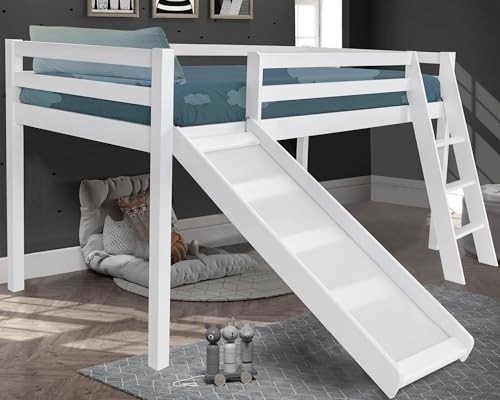Bunk Beds Sale: A Comprehensive Guide to Choosing the Right Bunk Bed for Your Home
Bunk beds have long been a staple in kids's bed rooms, offering a mix of space-saving efficiency and fun. Whether accommodating brother or sisters, pals on sleepovers, or merely maximizing a playroom, bunk beds have become a vital component in contemporary family homes. As sales on bunk beds increase, it ends up being increasingly important for customers to make informed choices when acquiring one. This article will cover the fundamentals of acquiring a bunk bed, from types to security features, along with tips for maintaining the integrity of your financial investment.
Kinds Of Bunk Beds
When considering a bunk bed sale, it's essential to comprehend the different designs available on the market. Below are the most common types:
- Traditional Bunk Beds: These include 2 beds stacked one above the other, sharing a single frame. They are often the most affordable option.
- L-Shaped Bunk Beds: This design includes one bed placed vertically and another horizontally. Bunk Beds Children's produces additional space beneath the upper bed, which can be utilized for storage or a backyard.
- Lofted Beds: Similar to conventional bunk beds however with no lower bed. Instead, the space underneath can be utilized for a desk, play location, or extra storage.
- Triple Bunk Beds: For households with a larger number of kids or regular pajama parties, triple bunk beds offer three sleeping areas in a space-efficient style.
- Futon Bunk Beds: These styles merge bunk beds and futon couches. The bottom section transforms into a different seating location, enhancing performance.
- Convertible Bunk Beds: These beds can be separated into 2 individual beds, making them flexible as kids's requirements alter over time.
Table 1: Comparison of Bunk Bed Types
| Type | Description | Space Efficiency | Extra Features |
|---|---|---|---|
| Traditional Bunk Bed | Two beds stacked vertically | High | Simplest design |
| L-Shaped Bunk Bed | One vertical and one horizontal bed | Moderate | Play or storage space |
| Lofted Bed | Elevated bed with open space listed below | High | Work/play area |
| Triple Bunk Bed | 3 stacked beds | Very High | Accommodates more users |
| Futon Bunk Bed | Bunk bed with a convertible futon | High | Multi-functional |
| Convertible Bunk Bed | Can be split into two different beds | Moderate | Versatility & & durability |
Safety Features to Consider
Security is critical when buying a bunk bed. Below are crucial safety functions to look for:
- Guardrails: Adequate guardrails ought to be present on both sides of the upper bunk to avoid falls. They need to be at least 5 inches higher than the bed mattress.
- Ladder Design: Look for sturdy, large ladders with slip-resistant rungs. Guarantee that the angle is not too steep for easy gain access to.
- Stability: Ensure the bed is built with strong products, such as solid wood or sturdy metal. The bed ought to not wobble when in use.
- Weight Limit: Check the weight capacity of the bunk bed to ensure it can accommodate the designated users safely.
- Material Safety: If possible, select beds made from non-toxic materials or those meeting security standards for children's furniture.
Table 2: Essential Safety Features
| Feature | Description | Significance |
|---|---|---|
| Guardrails | Sides of upper bed to prevent falls | Essential for child security |
| Ladder Design | Strong, slip-resistant rungs | Aids safe and simple access |
| Stability | Build quality to prevent wobbling | Guarantees security and durability |
| Weight Limit | Optimum weight capacity | Prevents accidents |
| Material Safety | Non-toxic, safe materials | Protects children's health |
Maintenance Tips for Bunk Beds
To extend the life of your bunk bed and ensure ongoing safety, think about the following upkeep suggestions:
- Regular Inspections: Periodically examine the structure for loose screws, bolts, or any indications of wear. Tighten up fasteners as essential.
- Tidy Periodically: Dust and tidy the surfaces frequently. Use appropriate cleaners that won't harm the surface.
- Inspect Weight Limits: Be mindful of weight limits, especially with older kids or adults who may want to use the upper bunk.
- Prevent Climbing on Guardrails: Educate kids not to use guardrails for climbing up or playing to minimize the risk of accidents.
Regularly Asked Questions (FAQs)
Q1: What is the age limitation for kids to securely use bunk beds?A: While it varies by the manufacturer, lots of recommend that kids under 6 ought to not sleep in the upper bunk due to safety concerns.
Q2: How can parents dissuade hazardous climbing?A: Setting clear guidelines about bunk bed usage and monitoring kids can assist. In addition, using a bed camping tent can dissuade climbing while creating an enjoyable sleep environment.
Q3: What should I think about when embellishing a room with bunk beds?A: Ensure there is sufficient space around the bunk bed for safe motion, and utilize the decoration to produce individualized areas for each child.
Q4: Is a lofted bed ideal for older children?A: Yes, lofted beds can be suitable for older children as long as they fulfill safety requirements and the kid is responsible enough to utilize them securely.
Bunk beds serve a practical function while adding an element of enjoyable to a kid's bedroom. As sales of bunk beds continue to rise, careful factor to consider of types, safety features, and upkeep practices is vital for moms and dads and caregivers. By comprehending these crucial elements, households can find the ideal bunk bed for their home, guaranteeing both functionality and safety for years to come. Whether it's for brother or sisters sharing a space or creating a relaxing sleepover space, a well-chosen bunk bed can provide happiness and functionality, making it a worthy financial investment.

